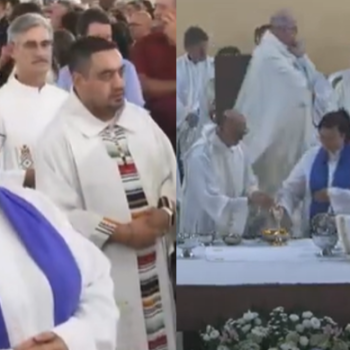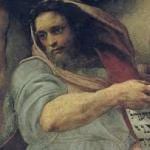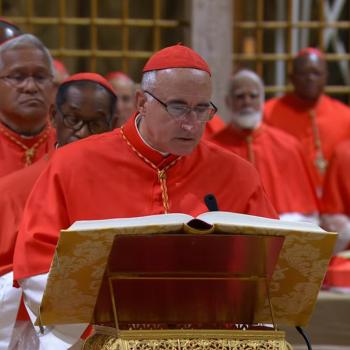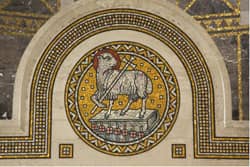 The Triumphant Lamb from Revelation; mosaic from the altar of the Church of Augusta Victoria, Mount of Olives, Jerusalem (photo by William Hamblin)
The Triumphant Lamb from Revelation; mosaic from the altar of the Church of Augusta Victoria, Mount of Olives, Jerusalem (photo by William Hamblin)
- Messiah as conquering Lamb. Although the association of the Messiah with a lamb is never explicitly made in the Hebrew Bible, it is found in some intertestamental literature. Enoch 89 gives an extended allegorical prophecy where Israel is described as sheep being ravaged by wild animals until the Lord raises a sheep, the Messiah, who defends and saves them (Enoch 89:41-50 = OTP 1:67). Likewise, the Testament of the Twelve Patriarchs, describes a Messianic Lamb: "I saw a virgin was from Judah, wearing a linen stole; and from her was born a spotless lamb. . . . And all the wild animals rushed against him, but the lamb conquered them, and destroyed them, trampling them underfoot" (Joseph 19:8 = OTP 1:824). This Testament probably dates from the 2nd century B.C.E., and although many scholars see parts of 19:8 as a later Christian interpolation, it is likely that the conquering lamb-Messiah symbolism is ancient, and thus may have influenced John. This conquering Lamb imagery is most clearly found in the book of Revelation. There, however, the Greek term for Lamb is arnion, while in John 1 it is amnos, so the connection between the two may seem more explicit in English than it would have appeared to first-century Greek readers.
- Finally, there is the image of the Lamb as a sacrificial offering in the Israelite temple cult. (Note by cult I mean system of ritual and sacrifice, not a fringe religious movement.) The emphasis here is on Christ's death as an atoning sacrifice typologically linked to the sacrificial sheep in the temple. In the Septuagint, the term amnos generally has reference to a one-year-old lamb required in certain expiatory sacrifices (Lev. 14; Num. 7), as well as the regular sacrificial schedule (Num. 28-29). Likewise, Ezekiel's temple vision requires amnos/lamb sacrifices. All of these passages talk about a one-year-old amnos, using precisely the same Greek term as John's "Lamb of God." They are also frequently required to be "without blemish" (amōmos), just as the amnos/lamb of 1 Peter 1:19. This is the most clear connection to a lamb that "takes away the sins of the world," but it lacks a clear context of why this should lamb should be associated with the Messiah.
Thus, although there are a number of possible antecedents to the idea of the Lamb of God in John, it is not certain which one John had in mind, or if he is alluding to a combination of several or even all these concepts.
Baptism/Water Immersion
What did immersion in water mean in first-century Palestine? Basically there were three different aspects to Jewish water immersion: 1) body purification (for entrance to the temple); 2) proselyte baptism, and 3) initiation into a Jewish sect. Christian baptism may have been a combination of all three of these elements.
Body purification immersions began in ancient Israel as a requirement for priests before they could enter the temple if they had been defiled through contact with the dead, certain sicknesses, blood, or unclean substances (Lev. 11-15). This developed into regular priestly immersions to insure purification in case of unknown defilement. The reason the priest and Levites were unwilling to help the stricken man on the road to Jericho was in part because contact with blood and death would render them defiled and unable to perform their duties in the temple (Lk. 10:25-37). Initially these requirements seem to have applied only to priests, but they were eventually required of all who entered the temple, probably to prevent surreptitious defilement of priests by contact with unclean worshippers inside the temple precinct. Only if all who entered the temple were ritually pure could it be guaranteed that priests would not become defiled by accidentally touching someone who was impure. Furthermore, by the first century many Jews felt that they should try to remain in a temple-worthy purified state throughout daily life, even if they did not have immediate plans to visit the temple.
By the time of Jesus anyone wishing to enter the temple was required to immerse himself in a mikveh, a special ritual immersion pool. Dozens of these from the first century have been discovered by archaeologists (see photos). The practice still continues among many Jews today before the Sabbath, and on other special occasions. This immersion, however, was done by oneself. The person simply entered the pool, dunked himself under the water (perhaps several times), and came out of the water. No one was required to immerse you.
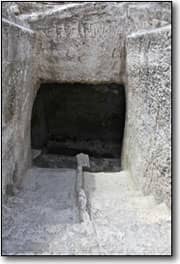
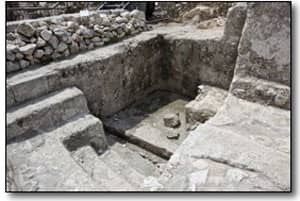 Two mikvot from the time of Jesus, uncovered in excavations on the southeast corner of the Temple Mount, Jerusalem. Jews preparing to enter the temple would descend the steps and immerse themselves in a pool of water. (Photos by W. Hamblin)
Two mikvot from the time of Jesus, uncovered in excavations on the southeast corner of the Temple Mount, Jerusalem. Jews preparing to enter the temple would descend the steps and immerse themselves in a pool of water. (Photos by W. Hamblin)
